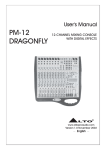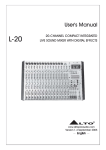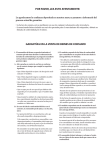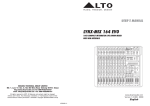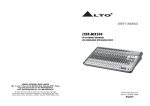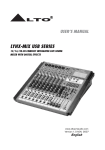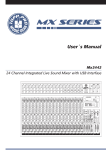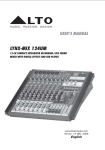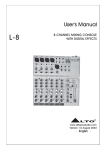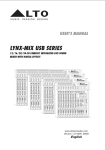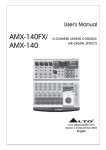Download Alto L-12 User`s manual
Transcript
User's Manual L-12 12-CHANNEL COMPACT INTEGRATED LIVE SOUND MIXER WITH DIGITAL EFFECTS R LTO www.altoproaudio.com Version 1.0 August 2003 English the recommended fuse type as indicated in this manual. Do not short-circuit the fuse holder. Before replacing the fuse, make sure that the product is OFF and disconnected from the AC outlet. SAFETY RELATED SYMBOLS CAUTION RISK OF ELECTRIC SHOCK DO NOT OPEN Protective Ground This symbol, wherever used, alerts you to the presence of un-insulated and dangerous voltages within the product enclosure. These are voltages that may be sufficient to constitute the risk of electric shock or death. Before turning the product ON, make sure that it is connected to Ground. This is to prevent the risk of electric shock. Never cut internal or external Ground wires. Likewise, never remove Ground wiring from the Protective Ground Terminal. This symbol, wherever used, alerts you to important operating and maintenance instructions. Please read. Operating Conditions Always install in accordance with the manufacturer's instructions. Protective Ground Terminal To avoid the risk of electric shock and damage, do not subject this product to any liquid/rain or moisture. Do not use this product when in close proximity to water. AC mains (Alternating Current) Hazardous Live Terminal ON: Denotes the product is turned on. Do not install this product near any direct heat source. OFF: Denotes the product is turned off. Do not block areas of ventilation. Failure to do so could result in fire. Keep product away from naked flames. WARNING Describes precautions that should be observed to prevent the possibility of death or injury to the user. IMPORTANT SAFETY INSTRUCTIONS CAUTION Read these instructions Describes precautions that should be observed to prevent damage to the product. Follow all instructions Keep these instructions. Do not discard. Heed all warnings. WARNING Only use attachments/accessories specified by the manufacturer. Power Supply Ensure that the mains source voltage (AC outlet) matches the voltage rating of the product. Failure to do so could Power Cord and Plug result in damage to the product and possibly the user. Unplug the product before electrical storms occur and when unused for long periods of time to reduce the risk of Do not tamper with the power cord or plug. These are designed for your safety. electric shock or fire. If the plug does not fit your AC outlet seek advice from a qualified electrician. Do not remove Ground connections! External Connection Always use proper ready-made insulated mains cabling (power cord). Failure to do so could result in shock/death or fire. If in doubt, seek advice from Protect the power cord and plug from any physical stress to avoid risk of electric shock. Do not place heavy objects on the power cord. This could cause electric shock or fire. a registered electrician. Cleaning Do Not Remove Any Covers Within the product are areas where high voltages may present. To reduce the risk of electric shock do not remove any covers unless the AC mains power cord is removed. When required, either blow off dust from the product or use a dry cloth. Do not use any solvents such as Benzol or Alcohol. For safety, keep product clean and free from dust. Covers should be removed by qualified service personnel only. Servicing No user serviceable parts inside. Refer all servicing to qualified service personnel only. Do not perform any servicing other than those instructions contained within the User's Manual. Fuse To prevent fire and damage to the product, use only 1 PREFACE Dear Customer: Thank you for choosing the LTO L-12 12-Channel Compact Integrated Live Sound Mixer with Digital Effects, which is the result of our LTO AUDIO TEAM's endeavours. For the LTO AUDIO TEAM, music and audio is more than a profession, it is a passion and an obsession! We have, in fact, been designing professional audio products for a number of years in cooperation with many of the world's major brands. The LTO line represents unparalleled analogue and digital products made by musicians, for musicians. With our design centres in Italy, the Netherlands, and the United Kingdom we provide you with world-class designs, while our software development teams continue to develop an impressive range of audio specific algorithms. By purchasing our LTO products you become the most important member of our LTO AUDIO TEAM. We would like to share with you our passion for what we design and invite you to make suggestions, which will aid us in developing future products for you. We guarantee you our commitment for quality, continual research and development, and of course the best prices. The LTO L-12 is an extremely flexible, ultra-low noise 12-channel compact integrated live sound mixer with Digital Effects, configured with 4 mono and 4 stereo input channels, each channel is equipped with a variety of key features including a warm, natural sounding EQ, Peak LEDs and PAN/BAL control etc.. Besides, the L-12 is equipped with the miraculous 24 bit digital stereo effect processor with 256 presets. Seeing is believing, let's meet the LTO L-12. We would like to thank all the people who made the LTO L-12 12-Channel Compact Integrated Live Sound Mixer with Digital Effects possible, especially to our designers and LTO staff. It is their passion for music and professional audio that has made it possible for us to offer you, our most important team member, our continued support. Thank you very much LTO AUDIO TEAM 2 TABLE OF CONTENTS 1. INTRODUCTION...................................................................................................................................................4 2. FEATURES...........................................................................................................................................................5 3. READY TO START?...............................................................................................................................................6 4. CONTROL ELEMENTS.......................................................................................................................................7 4.1 The mono MIC/LINE channels....................................................................................................................8 4.2 INPUT LEVEL setting..................................................................................................................................8 4.3 Mono Channel INSERT................................................................................................................................8 4.4 LOW-CUT FILTER......................................................................................................................................8 4.5 STEREO INPUTS........................................................................................................................................9 4.6 EQUALISER.................................................................................................................................................9 4.7 AUX SEND................................................................................................................................................10 4.8 PAN............................................................................................................................................................10 4.9 SG/PEAK....................................................................................................................................................10 4.10 MUTE.........................................................................................................................................................10 4.11 FADER ......................................................................................................................................................11 4.12 ASSIGNMENT Control......................................................................................................... .....................11 4.13 MASTER SECTION ..................................................................................................................................11 4.14 REAR PANEL DESCRIPTION ...................................................................................................................15 5. INSTALLATION AND CONNECTION.....................................................................................................................18 6. PRESET LIST........................................................................................................................................................21 7. SYSTEM BLOCK DIAGRAMS.............................................................................................................................28 8. TECHNICAL SPECIFICATION..............................................................................................................................29 9. WARRANTY...........................................................................................................................................................31 3 1. INTRODUCTION Thank you very much for expressing your confidence in LTO products by purchasing LTO L-12 12 Channel Compact Integrated Mixer with Digital Effects. The L-12 is professional compact mixer. You will get the smooth, accurate more natural and open sound from this apparatus, it is really ideal for large gigs, recording and fixed PA installations. The L-12 12 Channel Compact Integrated Mixer with Digital Effects is packed with features that can not be found in other consoles of its size: 6 mono (these are provided with Ultra Low Noise microphone pre-amplifiers and Phantom Power at +48 Volt) and 4 stereo input channels, and each of them is provided with warm, natural EQ (channel1-4 are mono channels and equipped with 3 band MID sweep EQ; channel 5-12 are stereo channels and equipped with 4 band fixed frequency EQ); 24 bits digital stereo effect processor with 256 presets (16 presets 16 variations); 4-AUX sends; separate level control on each channel; highly accurate 12-segment bar graph meters; 2-Track inputs assignable to main mix, control room / headphone outputs; subgroups output and small and exquisite modelling. Your L-12 is very easy to operate but we advise you to go through each Section of this Manual carefully. In this way you will get the best out of your L-12. 4 2. FEATURES The L-12 12 Channel Compact Integrated Mixer with Digital Effects is designed for professional appliance. It will provide the following features: 6 MIC input channels with gold plated XLRs and balanced LINE inputs 4 Stereo input channels with balanced TRS jacks Ultra-low noise discrete Mic Preamps with +48V Phantom Power Extremely high headroom offering more dynamic range 60mm high precision faders Each input channel with Mute, SOLO function, overload & signal present LEDs and low cut filters (except for stereo channel) SUB 1-2, SUB 3-4 and MAIN L-R signal assignment switch 4 AUX sends per channel: 2 PRE/POST faders switch-able for monitoring application effects & sound processor input; 2 POST faders for internal digital DFX or as external send 4-band fixed EQ on stereo line channels 3-band EQ with swept mid on microphone channels Channel inserts and direct outputs on each mono channel plus main mix insert for flexible connection of outboard equipment 24-bit DSP effect 256 effects (16 presets 16 variations) Stereo 9-band graphic EQ TNC socket for connecting lamp Control room/phones matrix 2-TRACK IN assignable to main mix, control room/headphone outputs Highly accurate 12 segment output level meters 5 3. READY TO START? 3.1 Please check the AC Voltage available in your Country before connecting your L-12 to the AC socket. 3.2 Be sure that the main power switch is turned off before connecting the Mixer to the AC socket. Also, you should make sure that all Input and Output Controls are turned down. This will avoid damages to your speakers and avoid excessive noise. 3.3 Before turning on the L-12 you shall connect it to a power amplifier and turn-on the mixer BEFORE the power amplifier. Once you have finished your working session you shall turn the mixer off AFTER the power amplifier. 3.4 Before disconnecting the L-12 always turn-off the Power switch. 3.5 Do not use solvents to clean your L-12. A dry and clean cloth will be OK. 6 4. CONTROL ELEMENTS MIC 1 MIC 2 MIC 3 MIC 4 MIC 5 MIC 6 2-TRACK IN/OUT L LTO R L-12 12 CHANNEL COMPACT INTEGRATED LIVE SOUND MIXER 2 1 2 3 1 2 3 1 2 3 1 2 3 1 2 3 1 R DIGITAL EFFECTS WITH LAMP 12V 0.5A 3 TAPE IN TAPE OUT LINE IN 7 LEFT (MONO) BAL/UNBAL BAL/UNBAL BAL/UNBAL INSERT RIGHT LINE IN 10 RIGHT RIGHT TRIM TRIM TRIM 2 3 4 0dB 60dB MIC +15dB -45dB LINE 0dB 60dB MIC +15dB -45dB LINE 0dB 60dB MIC +15dB -45dB LINE 0dB 60dB MIC +15dB -45dB LINE LOW CUT 75Hz 18dB/Oct LOW CUT 75Hz 18dB/Oct LOW CUT 75Hz 18dB/Oct LOW CUT 75Hz 18dB/Oct 0 0 EQ EQ HI 12kHz -15 0 +15 -15 0 800 +15 -15 -15 800 0 8kHz -15 -15 100Hz 0 8kHz -15 AUX 100Hz 0 -15 800 0 -15 -15 AUX 0 -15 AUX +15 EFFECTS OUT +20 -15 0 -15 -15 0 - +15 AUX1 0 16 1 2 3 15 14 13 12 11 4 5 6 7 10 9 8 PRESETS 16 1 2 3 4 5 6 10 9 8 7 VARIATIONS 0 -15 -15 0 -15 0 -15 0 +15 -15 0 +15 MID-LOW 500Hz +15 -15 0 -15 -15 AUX 125 250 EQ OFF EQ ON +15 +15 +10 +5 +5 0 0 -5 -5 -10 -10 -15 STEREO GRAPHIC EQ AUX SENDS +15 STEREO AUX RETURNS 0 1 AUX 0 1 CTRL ROOM SOURCE 0 1 0 +15 - 2 0 +15 - 2 0 +15 - 2 0 +15 - 2 0 +15 - 2 0 +15 - 2 0 +15 - 8 - 2 SOLO 8 +15 8 0 8 - 2 8 +15 8 0 8 - 2 8 +15 8 0 8 8 - MAIN MIX 2 - +15 0 SUB 1-2 TO AUX SEND2 - POST PRE +15 - POST PRE +15 SUB 3-4 SOLO - +15 - +15 - MAX CTRL ROOM +15 2TK IN - 4 DFX2 (INT) +15 - 4 - 4 +15 - - 4 DFX2 (INT) +15 - 0 - 10 4 DFX2 (INT) +15 CLIP - +15 0 SOLO +15 4 PAN PAN PAN BAL +15 - BAL 0 +15 SUB 1/2 - +15 BAL MAIN MIX CTRL/R SOLO +15 2TK TO MIX 7 4 DFX2 (INT) SOLO 2 LEVEL SET -2 AUX RETURN 0 - +15 4-DFX2 RETURN 4 - DFX2 SEND PAN - 8 0 +15 8 - DFX2 (INT) DFX2 (INT) +15 0 +15 3 DFX1 (EXT) 8 - 8 0 +15 8 - 3 DFX1 (EXT) 0 8 +15 0 +15 3 DFX1 (EXT) 0 8 4 DFX2 (INT) 8 - 8 DFX2 (INT) 0 - 3 0 8 4 +15 8 0 - 0 8 4 +15 3 DFX1 (EXT) DFX1 (EXT) 8 0 - 3 DFX1 (EXT) 0 8 4 +15 8 8 - 3 DFX1 (EXT) 0 8 3 DFX1 (EXT) 0 8 3 0 8 3 0 8 0 MAX PHONES 8 POST PRE +15 8 - 8 POST PRE +15 8 - 8 POST PRE +15 8 - 8 POST PRE +15 8 - 8 POST PRE +15 8 - 8 POST PRE +15 8 - 16K 8K +10 TO AUX SEND1 2 PHANTOM PEAK 4K 2K -15 0 1 1K 500 +15 LOW 80Hz +15 0 1 AUX DSP MUTE +15 AUX2 63 HI-MID 3kHz LOW 80Hz +15 - +15 MID-LOW 500Hz +15 0 1 EQ HI-MID 3kHz +15 DFX2(INT) RETURN EFFECTS TO MONITOR HI 12kHz +15 LOW 80Hz +15 AUX EQ MID-LOW 500Hz +15 0 HI 12kHz HI-MID 3kHz +15 0 1 15 14 13 12 11 PWR +15 LOW 80Hz +15 0 1 -20 0 EQ MID-LOW 500Hz 8kHz 0 LINE GAIN 11/12 +20 HI 12kHz -15 0 LOW 80Hz +15 0 1 0 +15 FREQ 100Hz 8kHz -15 0 -20 60dB MIC HI-MID 3kHz +15 LOW 80Hz -15 AUX -15 0 +15 FREQ +15 0 1 0 0 LINE GAIN 9/10 9. SPRING REVERB 10. MONO DELAY 11. STEREO DELAY 12. FLANGER 13. CHORUS 14. REVERB + DELAY 15. REVERB + FLANGER 16. REVERB + CHORUS LOW CUT 75Hz 18dB/Oct EQ MID +15 LOW 80Hz +15 0 800 FREQ LOW 80Hz 1 -15 +15 0dB HI 12kHz HI 12kHz MID +15 FREQ 100Hz 0 60dB MIC 0 B 0 MIC GAIN 6 LOW CUT 75Hz 18dB/Oct EQ HI 12kHz MID +15 0 EQ HI 12kHz MID -15 0 MIC GAIN 5 0dB RIGHT DIGITAL STEREO EFFECTS PROCESSOR 1. VOCAL 1 2. VOCAL 2 3. LARGE HALL 4. SMALL HALL 5. LARGE ROOM 6. SMALL ROOM 7. PLATE 8. TAPE REVERB LINE IN 12 0 TRIM 1 A BAL/UNBAL LINE IN 8 LINE IN 6 INSERT 24BITs PHONES LEFT (MONO) 8 BAL/UNBAL INSERT LINE IN 11 LEFT (MONO) LEFT (MONO) 8 BAL/UNBAL INSERT LINE IN 9 8 LINE IN 5 LINE IN 4 8 LINE IN 3 LINE IN 2 LINE IN 1 SUB 3/4 MAIN MIX BAL -4 -7 LEFT LEFT LEFT RIGHT LEFT RIGHT LEFT RIGHT LEFT RIGHT LEFT RIGHT LEFT RIGHT LEFT RIGHT LEFT LEFT LEFT SOLO ACTIVE -10 RIGHT -20 -30 SG/PEAK SG/PEAK MUTE SG/PEAK MUTE SG/PEAK MUTE SG/PEAK MUTE SG/PEAK MUTE SG/PEAK MUTE RIGHT SG/PEAK RIGHT RIGHT RIGHT SUBGROUPS ASSIGN TO MAIN MIX SOLO MODE L R PFL OUTPUT LEVEL AFL MUTE MUTE 10 10 10 10 10 10 10 10 10 10 10 10 10 dB dB dB dB dB dB dB dB dB dB dB dB dB 5 5 5 5 5 5 5 5 5 5 5 5 5 SUB 1-2 SUB 1-2 SUB 1-2 SUB 1-2 SUB 1-2 SUB 1-2 SUB 1-2 SUB 1-2 0 0 0 0 0 0 0 0 0 0 0 0 0 -5 -5 -5 -5 -5 -5 -5 -5 -5 -5 -5 -5 -5 -10 -10 -10 -10 -10 -20 -20 -20 -20 -20 SUB 3-4 -10 SUB 3-4 -10 -20 -20 MAIN L-R SUB 3-4 -10 -20 MAIN L-R SUB 3-4 -10 -20 MAIN L-R SUB 3-4 -10 -20 MAIN L-R SUB 3-4 -10 -20 MAIN L-R SUB 3-4 -10 -20 MAIN L-R SUB 3-4 -10 -20 MAIN L-R MAIN L-R -25 -25 -25 -25 -25 -25 -25 -25 -25 -25 -25 -25 -25 -30 -40 -30 -40 -30 -40 -30 -40 -30 -40 -30 -40 -30 -40 -30 -40 -30 -40 -60 -30 -40 -60 -30 -40 -60 -30 -40 -60 -30 -40 -60 -60 -60 SOLO 1 -60 SOLO 2 -60 SOLO 3 -60 SOLO 4 -60 SOLO 5/6 -60 SOLO 7/8 -60 SOLO 9/10 SOLO 11/12 SUB1 SUB2 SUB3 SUBGROUPS 7 SUB4 MAIN MIX LEVEL 4. CONTROL ELEMENTS 1 4.1 The mono MIC/LINE channels These are Channel 1 through Channel 4. You can connect balanced, low impedance microphones to the XLR socket. On the 1/4" phone jack you can connect either a microphone or a line level instrument. You shall never connect an unbalanced microphone to the XLR socket if you do not want to damage both the Microphone and the Mixer. 48 Volt phantom power MIC 1 2 1 3 4 1 LINE IN 1 It is available only to the XLR Mic sockets. Never plug in a microphone when phantom power is already on. Before turning phantom power on, make sure that all faders are all the way down. In this way you will protect your Stage Monitors and Main Loudspeakers. BAL/UNBAL INSERT 3 2 4.2 INPUT LEVEL setting TRIM This Control is provided with 2 different indication rings: One is for the Microphone and the other for the Line levels. When you use a microphone you shall read the OUTSIDE ring (0-60 dB), When you use a Line level instrument you shall read the INSIDE ring (+15~-45 dB). For optimum operation you shall set this control in a way that the peak LED will blink also occasionally in order to avoid distortion on the input channel. 2 0dB 60dB MIC +15dB -45dB LINE LOW CUT 75Hz 18dB/Oct 5 3 4.3 Mono Channel INSERT Insert points are provided for the Mono Mic Channels. When you insert a TRS jack in the insert socket, the signal will be taken out after the Input Gain Control (Trim), sent to an external processor such as a compressor-limiter, and returned into the channel strip immediately before the EQ section. Of course, the jacks used must be stereo (Tip Send/Ring Return). 4.4 LOW-CUT FILTER 1 POWER PHANTOM ON 4 OFF 5 By pressing this button you will activate a 75 Hz low frequency filter with a slope of 18 dB per octave. You can use this function to reduce hum and stage rumble when using microphones. 8 6 4.5 STEREO INPUTS MIC 6 These are Channel 5 through 12. They are organised in stereo pair (5/6 and 7/8 pairs also feature XLR Mic inputs 5 and 6) and they are provided with 1/4" TRS phone sockets. 2 1 3 If you connect only the left jack, the input will operate in mono mode. LINE IN 7 6 LINE IN 9 LEFT (MONO) LEFT (MONO) BAL/UNBAL Your L-12 also provides the practical input level setting: MIC GAIN (the adjustable range is from 0dB to 60dB) for MIC 5/MIC 6 and LINE GAIN (the adjustable range is from -20dB to +20dB) for LINE IN 9/10 and LINE IN 11/12. LINE IN 8 LINE IN 10 RIGHT RIGHT 0 MIC GAIN 6 0dB LINE GAIN 9/10 -20 60dB MIC +20 4.6 EQUALISER The mono input channels (channel 1- channel 4) are equipped with 3 band MID sweep EQ: HI band, MID band and LOW band; And the stereo channels (channel 5-channel 12) are equipped with 4 band fixed frequency equalization: HI band, HI-MID band, MID-LOW band and LOW band. All bands provide up to 15dB of boost or cut. 0 0 EQ 7 EQ HI 12kHz HI 12kHz -15 0 -15 0 +15 +15 HI-MID 3kHz MID 7 -15 8 This is the Treble control. You can use it to get rid of high frequency noises or to boost the sound of cymbals or the high harmonics of the human voice. The gain range goes from -15dB to +15dB with a center frequency of 12 kHz. 800 +15 MID-LOW 500Hz FREQ 100Hz 0 -15 8kHz 0 +15 LOW 80Hz LOW 80Hz -15 -15 +15 0 1 AUX +15 0 1 AUX - +15 - 2 +15 POST PRE 0 3 8 0 - 0 +15 +15 8 - 2 8 This is the Midrange control. It provides 15dB of boost or cut, flat at the center detent and the FREQ knob sets the center frequency, the adjustable range is from 100Hz to 8kHz. It can affect most fundamental frequencies of all musical instruments and human voice. An attentive use of this control will give you a very wide panorama of sound effects. 8 8 - 4 0 DFX1 (EXT) +15 - 4 0 +15 DFX2 (INT) - This control gives you up to 15dB boost or cut at 3kHz. It is useful for controlling voice. It can accurately polish your performance via adjusting this knob. 9 +15 - 8 9 8 DFX2 (INT) 4.6.3 HI-MID +15 PAN LEFT RIGHT POST PRE 0 3 DFX1 (EXT) 8 4.6.2 MID -15 0 +15 8 4.6.1 HI BAL LEFT RIGHT 9 10 4.6.4 MID-LOW This control gives you up to 15dB boost or cut at 500Hz. 0 11 4.6.5 LOW 0 EQ EQ HI 12kHz HI 12kHz This is the Bass control. Boost male voice or kickdrum and bass guitar. Your system will sound much bigger than what it is. The gain range goes from -15dB to +15dB and the center frequency is 80 Hz. -15 0 -15 0 +15 +15 HI-MID 3kHz MID -15 800 -15 0 +15 +15 MID-LOW 500Hz FREQ 100Hz 12 2 AUX3 and AUX4 are configured as POST-Faders. - LOW 80Hz 0 +15 - 2 POST PRE +15 0 3 8 -15 +15 - 0 +15 POST PRE +15 12 0 3 - 4 0 DFX1 (EXT) +15 - 4 0 +15 DFX2 (INT) +15 - 13 8 - 8 DFX2 (INT) 4.8 PAN Besides, the PAN or BAL control has the same affection to SUB 1-2 and SUB 3-4 if the SUB 1-2 or SUB 3-4 push-button is pressed, Of course a wide number of intermediate positions is available. BAL 13 LEFT LEFT RIGHT SG/PEAK 15 MUTE MUTE 10 10 dB dB 5 5 SUB 1-2 0 SUB 1-2 0 -5 -5 -10 SUB 3-4 -10 -20 -20 MAIN L-R 14 Inside your L-12 the audio signal is monitored in several different stages and then sent to the SG/PEAK LED. When the LED shows green, it indicates that there present signal on corresponding channel; When the LED turns into red, it warns you that you are reaching signal saturation and possible distortion, then you should reduce the input level for avoiding distortion. 4.9 MUTE 15 Each channel is equipped with the MUTE switch. Pressing this switch is equal to turning the fader down, which can mute the corresponding channel output except for the PRE AUX sends, channel INSERT send and SOLO (in PFL mode). And the MUTE LED will illuminate. 10 RIGHT 14 SG/PEAK SUB 3-4 4.9 SG/PEAK +15 PAN This is the PANORAMA control, or balance control. Rotate this control to determine the amount of channel signal sent to left/ right of MAIN MIX when Main L-R push-button is pressed. Keep this control in center position and your signal will be positioned in the middle of stage. Turn this control fully counterclockwise, the signal will be present only on the left of MAIN MIX and vice-versa. 11 +15 DFX1 (EXT) 8 In this typical compact unit, excluding sending out directly to the external effect or processor equipment, AUX SEND 4 can also be assigned to the internal onboard effect module. 0 8 - 8 -15 8 AUX1 and AUX2 can be switched to PRE/POST-FADER via the PRE/POST button, so, generally, they can be used for monitor application and effects & sound processors input. 0 10 +15 LOW 80Hz These four controls are used to adjust the level of the signal sent to AUX buses, and their adjustable range goes from - to +15dB. 8 4.7 AUX SENDS Level Control -15 8kHz MAIN L-R -25 -25 -30 -40 -30 -40 -60 -60 SOLO 4 SOLO 5/6 4.10 FADER 16 This Fader will adjust the overall level of this channel and set the amount of signal sent to the Main output or the corresponding subgroup output. SG/PEAK SG/PEAK MUTE 4.11 ASSIGNMENT Control 17 Each channel provides four push-buttons: SUB1-2, SUB3-4, MAIN L-R and SOLO. MUTE 10 10 dB dB 5 5 16 SUB 1-2 SUB 1-2 0 0 -5 -5 SUB 3-4 Pressing the SOLO button, the corresponding SOLO LED will illuminate and the SOLO signal will replace other signals sent to the headphone/CONTROL ROOM and meters. Usually use the SOLO function in live work to preview channels before they are let into the mix. It is useful to set an instrument's input level and EQ, and you can also solo any channel that you want to. The SOLO switch never affects any mix other than the CONTROL ROOM. SUB 3-4 -10 -10 -20 17 -20 MAIN L-R MAIN L-R -25 -25 -30 -40 -30 -40 -60 -60 SOLO 4 SOLO 5/6 The other three buttons can be considered as signal assignment switches. Pressing the SUB 1-2 will assign the channel signal to Subgroup1/2, you can depend on the PAN switch to adjust the amount of channel signal sent to the SUB1 versus SUB2, when turns the PAN to completely left, then the signal can be only controlled by Subgroup1 and vice-versa. In the same way, pressing the SUB 3-4 or MAIN L/R will assign the channel signal to Subgroup3/4 or MAIN MIX L/R, and will also be affected by PAN. 4.12 MASTER SECTION 18 18 STEREO AUX RETURN AUX SENDS 0 1 0 1 CTRL ROOM SOURCE 0 1 2 - 2 0 +15 - 8 0 +15 8 8 - 2 0 - +15 SUB 1-2 TO AUX SEND2 Note: When any SOLO switch was engaged, the SOLO signal will replace other signals, and also be sent to the CONTROL ROOM, PHONES and METERS. - +15 2TK IN 0 3 MAX CTRL ROOM 8 +15 8 - 8 8 +15 MAX PHONES SUB 3-4 SOLO - 0 3 CLIP 4 0 +15 SOLO - 8 10 - 4 0 +15 MAIN MIX CTRL/R 19 +15 SOLO SOLO 2 LEVEL SET -2 AUX RETURN +15 4-DFX2 RETURN 4 - DFX2 SEND 7 0 - 8 8 - 2TK TO MIX 4 SUB 1/2 - PHONES/CTRL ROOM MAIN MIX TO AUX SEND1 SOLO 8 You can choose to monitor any combination of MAIN MIX, SUB1-2, SUB 3-4 and 2TK IN via these MATRIX switches. Engaging these switches, these stereo signals will be delivered to the PHONES, CONTROL ROOM and METERS display. 8 - Control Room Source SUB 3/4 MAIN MIX -4 -7 Rotate these knobs to adjust the stereo level of CTRL ROOM and PHONES outputs separately, which can be varied from - to MAX. LEFT LEFT LEFT LEFT RIGHT RIGHT RIGHT RIGHT SOLO ACTIVE -10 -20 -30 SUBGROUPS ASSIGN TO MAIN MIX 11 SOLO MODE L R PFL OUTPUT LEVEL AFL 19 20 21 22 AUX SENDS When the external effect unit connected to mixer has no input gain control, you can get a further +15dB gain available form these AUX SEND outputs. 23 STEREO AUX RETURNS 0 1 24 0 1 CTRL ROOM SOURCE 0 1 MAIN MIX 2 0 +15 - 2 0 +15 - 8 - 8 TO AUX SEND1 SOLO 2 - +15 0 SUB 1-2 TO AUX SEND2 SUB 3-4 SOLO 20 - 0 3 +15 0 3 CLIP 0 SOLO +15 - 8 - 4 0 +15 MAIN MIX CTRL/R 21 2 SUB 3/4 MAIN MIX LEVEL SET -2 -4 -. Master STEREO AUX RETURNS 26 30 25 -7 LEFT 27 LEFT LEFT LEFT SOLO ACTIVE -10 -20 -30 RIGHT RIGHT RIGHT RIGHT SUBGROUPS ASSIGN TO MAIN MIX 22 These four controls set the level of effects that received from the stereo AUX RETURN connectors, which can be varied from to +15dB. They are used to provide the further gain for low level effects. 10 10 10 10 dB dB dB dB dB 5 5 5 5 5 0 0 0 0 0 -5 -5 -5 -5 -5 -10 -10 -10 -10 -10 -20 -20 -20 -20 -20 -25 -25 -25 -25 -25 -30 -40 -60 -30 -40 -60 -30 -40 -60 -30 -40 -60 -30 -40 -60 SUB1 23 SOLO MODE L R PFL OUTPUT LEVEL AFL 10 SUB2 SUB3 SUBGROUPS -. TO AUX SEND1/2 SOLO AUX RETURN +15 4-DFX2 RETURN 4 - DFX2 SEND 7 0 - 8 8 SOLO +15 2TK TO MIX 4 SUB 1/2 - The function of these SOLO buttons are the same as the channel SOLO button, they can also be affected by SOLO MODE switch. Press the SOLO button, the corresponding AUX send will be routed to CTRL ROOM/ PHONES outputs and METERS display. 31 10 4 -. SOLO MAX CTRL ROOM 8 +15 8 - 8 8 +15 2TK IN 8 As to the AUX4, it can also provide the lovable level adjustment for the internal effect signal. - MAX PHONES 8 The four switches are used to determine the master AUX SEND levels, which can be varied from - to +15dB. 8 -. Master AUX SENDS 28 SUB4 32 MAIN MIX LEVEL 29 The both rotary knobs assign the AUX RETURN signals to their respective AUX SEND outputs: The TO AUX SEND1 assign the signal from AUX RETURN1 to AUX SEND1 bus, and TO AUX SEND2 assign the signal from AUX RETURN2 to AUX SEND2 bus. The adjustable range goes from - to +15dB. -. MAIN MIX - CTRL/R 24 AUX RETURN3 is equipped with the MAIN MIX / CTRL/R button. Release the button to send the stereo signal from AUX RETURN3 to MAIN MIX buses; Engage the button, then the stereo signal will be sent to CTRL/R output. 12 25 -. SUB1-2/3-4/MAIN MIX These three buttons are configured for AUX RETURN4, they can be regarded as the signal assignment switch. When engaging the SUB1-2, the stereo signal from AUX RETURN4 will be assigned to Submix1/2; in the same way, SUB3-4 for Submix3/4, MAIN MIX for MAIN MIX buses. 26 - AUX RETURN SOLO The function of AUX RETURN SOLO is like the channel SOLO button. Engaging it sends the signal from AUX RETURN (1-4) to the CTRL OUT, PHONES outputs and METERS display. It can also be affected by SOLO mode button, and the LED next the button will illuminate. - SUBGROUPS ASSIGN TO MAIN MIX 27 Through these switches, you can operate the subgroup faders as a master control for assigning the subgroups to MAIN MIX. Engage the LEFT switch to send the corresponding subgroup signal to MAIN MIX L, and the RIGHT switch for MAIN MIX R. When engaging the both switches, the signal will be sent to L/R of MAIN MIX. - SUBGROUPS 28 These faders are used to control the levels of signals sent to the SUBGROUPS OUT, the adjustable range is from - to +10dB. Any channel that is assigned to the subgroups, not muted and not turned down will be assigned to the SUB OUTS. 29 - MAIN MIX LEVEL This fader sets the amount of signal sent either to the Main Mix Output sockets or to the Tape Output. - LED METER 30 The stereo 12 segments LED Meter will indicate the signal level sent to CTRL ROOM and PHONE outputs. - 2TK TO MIX 31 Engaging this switch allows you to combine the 2 TRACK Output with the MAIN MIX. In other words, feeds the 2TRACK IN signals into MAIN L/R output. - SOLO MODE 32 This button provides two modes: up for PFL (Pre-Fader-Listen) mode, down for AFL (After-Fader-Listen) mode. Engage the button, the soloed signal will output following the LEVEL control, otherwise, release the button will output the soloed signal before the level control Please note that the SOLO function can never affect the mix at main recording output, and also can't be affected by channel's MUTE switch. 13 - 24 BIT DIGITAL EFFECTS 33 37 38 Adjust this knob to select the right effect you wish to perform. There are total 16 options for you: several kinds of reverb, mono and stereo delay, effects with modulation, and versatile two-effect combination. 33 0 0 8 +15 EFFECTS OUT - 8 PRESETS +15 AUX1 0 15 14 13 12 11 16 1 2 34 35 36 39 40 3 15 14 13 12 11 4 5 6 10 9 8 7 16 1 2 3 4 5 6 10 9 8 7 VARIATIONS PRESETS PWR 34 - Since you have selected the preferable effect, the next step, please go with the fine consideration, there are also total 16 variations for each preset, and each variation may be managed by several different factors. 35 125 250 500 DSP MUTE 1K 2K PEAK 4K PHANTOM 8K 16K +15 +15 +10 +10 +5 +5 0 0 -5 -5 -10 -10 -15 -15 STEREO GRAPHIC EQ This switch is used to activate/deactivate the effect facility. Sometimes, you can also use the DFX FOOT SWITCH (on rear panel) for convenient operation. PEAK LED +15 AUX2 63 EQ OFF EQ ON MUTE SWITCH 8 VARIATIONS DFX2(INT) RETURN EFFECTS TO MONITOR 41 42 36 This LED lights up when the input signal is too strong. In case of the digital effect module being muted, this LED also lights up. 37 EFFECTS OUT Rotate this knob to adjust the level of effect signal that intercepted from internal DSP processor and directly sent to DFX OUT, which can be varied from - to +15dB. 38 DFX2(INT) RETURN EFFECTS TO MONITOR These AUX1 and AUX2 controls are used to set the signal level from AUX RETURN4, which signal will be sent to AUX SEND1 and AUX SEND2. The adjustable range can be varied from - to +15dB. POWER LED 39 The LED indicates when the Power is on in your L-12. 40 PHANTOM LED This LED indicates when the Phantom Power is switched on. EQ switch 41 Engage this button to add the stereo graphic EQ into the MAIN MIX output circuit. It can be used to modify the frequency "contour" of a sound. If you release the button free, the stereo graphic EQ will be bypassed. STEREO GRAPHIC EQ 42 Each one of these faders will boost or attenuate (+/-15dB) the selected frequency at a preset bandwidth. When all the sliders are in the centre position, the output of the equalizer is flat response. 14 43 - 2-TRACK IN/OUT 2-TRACK IN/OUT TAPE IN Use the Tape input if you wish to listen to your Mix from a Taper Recorder or DAT. You can assign the signal coming from the Taper Recorder either to a pair of studio monitor using the Control Room assignment on the front panel or you can also send the signal directly to the Main Mix. L LAMP 12V 0.5A R TAPE IN TAPE OUT TAPE OUT These RCA jacks will route the main mix into a tape recorder. - LAMP 43 44 44 This lovable LAMP is very convenient for your operation, it is located in the top right corner of the front panel, and provides the 12V socket that can drive any standard TNC-type lamp. Please use the customized gooseneck lamps, the GL-SQ and GL-RO are both options. PHONES - PHONES 45 A These sockets will send out the monitor signal to a pair of headphones. 45 B 4.12 REAR PANEL DESCRIPTION - POWER ON/OFF switch 46 This switch is used to turn the Main Power ON and OFF. - PHANTOM ON/OFF switch 46 4 POWER PHANTOM 4 This switch will apply +48 Volt Phantom Power only to the 6 XLR microphone inputs. Never connect microphones when the Phantom Power is on already. ON OFF Use only with a 250V fuse - AC INLET WITH FUSE HOLDER 47 Use it to connect your L-12 to the Main AC with the supplied AC cord. Please check the Voltage available in your Country and how the Voltage for your L-12 is configured before attempting to connect your L-12 to the Main AC. AC INPUT EUROPE 210-240V 50Hz Fuse:T400mAL RATED POWER CONSUMPTION: 60W 47 15 Apparaten skall anslutas till jordat uttag nar den ansluts till ett natverk USA / Canada 100-120V 60Hz Fuse:T630mAL UK / Aust 240V 50Hz Fuse:T400mAL MAIN MIX OUTPUT (BAL/UNBAL) 49 MAIN INSERT +4dBu -30dBu L 2 1 MAIN OUTPUT LEVEL 3 TIP SEND RING RETURN MONO CTRL OUT DFX OUT 0 48 R 2 1 L L R R - 8 54 +15 L R 3 FOOT SWITCH (BAL/UNBAL) 50 52 51 53 55 48 - MAIN MIX OUTPUT This stereo output is supplied with both the XLR and 1/4" phone sockets and it is controlled by the Main Mix Level. 49 - MAIN OUTPUT LEVEL This button sets the main mix output level to match the input of the device that you are ready to connect. Engage this button to reduce the output level from MAIN MIX OUTPUT by 30dBu, it used to match the semipro -30dBu device, on the contrary, to match the professional +4dBu device. 50 - MAIN INSERT These two 1/4" phone sockets are stereo insert points and used to connect processors such as compressors, equalisers etc.. When insert a external processor into the jack, the Main stereo signal will be taken out after the EQ and returned into the MAIN MIX output before the MAIN MIX fader. 51 - MONO OUTPUT This 1/4" phone socket is balanced/unbalanced mono mix output connector, it can be regarded as a sum output of the left and right of MAIN MIX. 52 - MONO LEVEL This knob sets the level of mono mix output signal, which can be varied from - CTRL OUT to +15dB. 53 These 1/4" phone sockets will be used to send the control room signal to the Studio Monitor speakers or a second set of PA. - DFX OUT 54 This 1/4" phone socket is used to output the effect signal that comes from internal DSP module and the signal can be controlled in level by EFFECTS OUT control. - FOOTSWITCH 55 This 1/4" phone socket can be used to connect an external footswitch to turn on/off the onboard effect module. 16 56 58 DIRECT OUTS (BAL/UNBAL) AUX SENDS 1 2 1 2 3 CH4 4 CH3 AUX RETURNS CH1 CH2 SUBGROUPS OUT 3 1 4 2 3 4 59 L L L L R R R R 1 2 3 4 SUBGROUPS INSERT 57 - AUX SENDS 60 56 These 1/4" phone sockets are used to send out the signal from the AUX Bus to external devices such as effects. - AUX RETURNS 57 Use these stereo 1/4" phone sockets to return the sound of an effect unit to the Main Mix. You can also use them as an extra auxiliary input. - DIRECT OUTS 58 Each MONO MIC/LINE channel (CH1-CH4) is equipped the 1/4" phone socket for direct output. These jacks are used to send the signal from the channel path to external device for recording function etc.. - SUBGROUPS OUT 59 These 1/4" phone sockets are used to connect the inputs of deck or secondary in a complicated PA live sound system. You will find it is the best tool when you operate the SUBGROUPS OUT. - SUBGROUPS INSERT 60 These 1/4" phone sockets are insert points. They are used to connect processors such as compressor, limiter, EQ etc.. When insert external processor into these jacks, the subgroup stereo signal will be taken out, then returned to before subgroups fader. Of course, these jacks used must be stereo (Tip Send/Ring Return). 17 5. INSTALLATION AND CONNECTION Ok, you have got to this point and you are now in the position to successfully operate your L-12. However, we advise you to read carefully the following section to be the real Master of your own Mix. Not paying attention enough to the input signal level, to the routing of the signal and the assignment of the signal will result in unwanted distortion, a corrupted signal or no sound at all. So you should follow this procedure for every single channel: Turn down all Input and Output Gain Controls. Connect phantom powered microphones before switching on the +48Volt Phantom Power switch. If you have a power amplifier connected to your L-12 set the Level of the amplifier at no more than 75%. Now, set the CONTROL ROOM/PHONES level at no more than 50%. In this way you will be able to hear later what you are doing connecting a pair of headphones or a pair of powered studio monitor speakers. Position EQ controls on middle position. Position panoramic (PAN) control on center position. With a headphone or studio monitor speakers connected apply a Line Level input signal so that the PEAK LED does not light up. At this point increase the input gain so that the PEAK LED will blink occasionally. In this way you will maintain good headroom and ideal dynamic range. Now connect a microphone and ask the singer to sing loud into the microphone. Turn slowly the Gain Control clockwise and have the PEAK LED blink only occasionally. Now repeat the same sequence for all input channels. The Main LED Meter could move up into the red section. In this case you can adjust the overall output level through the MAIN MIX control. 18 5.1 SOME FINAL TIPS ON WIRING CONFIGURATION You can connect unbalanced equipment to balanced inputs and outputs. Simply follow these schematics. Ring=Right Signal Tip Sleeve Ring Strain Clamp Tip=Left Signal Sleeve=Ground/Screen Use for Headphone 1/4" Stereo (TRS) Jack Plug Sleeve Tip Tip=Signal Strain Clamp Sleeve=Ground/Screen Use for Mono Line In, Mono 1/4"Jack Plugs 1/4" Mono (TS) Jack Plug Sleeve Ring=Return Signal Tip Ring Strain Clamp Tip=Send Signal Sleeve=Ground/Screen Use for Insert Points 1/4" Stereo (TRS) Jack Plug 2=Hot(+) 2 1 3 2=Hot(+) 1=Ground/Screen 3=Cold(-) 2 1 3 1=Ground/Screen 3=Cold(-) Use for Balanced Mic Inputs (For unbalanced use, connect pin 1 to 3) Use for Main output (For unbalanced use, leave pin 3 unconnected) 3-pin XLR Male Plug 3-pin XLR Line Socket (seen from soldering side) (seen from soldering side) 19 Ring=Return Signal (Connected together) To Channel Insert Sleeve=Ground/Screen Tip=Signal To Tape or FX Input Sleeve=Ground/Screen 'Tapped' Connection Direct Output Lead (Enables the Insert to be used as a Direct Output while maintaining the channel signal flow) To Processor Input Sleeve=Ground/Screen Tip=Send Signal Tip To Channel Insert Sleeve Ring=Return Signal Ring To Processor Output -Stereo lead for insert Connection (To be used when the processor does not employ a single jack connection for the In/Out Connections) 20 6. PRESET LIST 01. VOCAL1 No 1 2 3 4 5 6 7 8 9 10 11 12 13 14 15 16 Pre-delay 84 30 0 55 10 79 45 45 25 0 45 114 40 50 45 55 Rev Time 1.00 1.00 4.50 3.60 1.20 3.60 0.8 1.50 2.40 0.90 1.50 1.00 1.00 2.10 4.50 1.70 Room Size 39 8 10 11 9 8 41 41 9 41 10 45 9 10 11 Rev. Type Hall Tape Spring Plate Spring Hall Plate Plate Spring Tape Plate Hall Spring Tape Plate Plate Hi Damp -12 -12 -12 -12 -12 -12 -12 -12 -12 -12 -12 -12 -12 -12 -12 -12 Pre-delay 114 45 79 10 55 0 30 84 55 45 50 40 114 45 0 25 Rev Time 1.00 0.80 3.60 1.20 3.60 4.50 1.00 1.00 1.70 4.50 2.10 1.00 1.00 1.50 0.90 2.40 Room Size 10 41 8 9 11 10 8 39 11 41 9 45 10 41 41 9 Rev. Type Spring Plate Hall Spring Plate Spring Tape Hall Plate Plate Tape Spring Hall Plate Tape Spring Hi Damp -12 -12 -12 -12 -12 -12 -12 -12 -12 -12 -12 -12 -12 -12 -12 -12 Pre-delay 55 55 40 40 50 50 27 27 Rev Time 5.40 5.40 5.40 5.40 4.50 4.50 4.50 4.50 Room Size 45 45 35 35 43 43 33 33 Hi Damp -0.96 -12.00 -0.96 -12.00 -0.96 -12.00 -0.96 -12.00 Rev level 79 79 78 78 82 82 82 82 02. VOCAL2 No 1 2 3 4 5 6 7 8 9 10 11 12 13 14 15 16 03. LARGE HALL No 1 2 3 4 5 6 7 8 21 9 10 11 12 13 14 15 16 50 50 27 27 45 45 23 23 4.00 4.00 4.00 4.00 3.60 3.60 3.60 3.60 42 42 32 32 41 41 30 30 -0.96 -12.00 -0.96 -12.00 -0.96 -12.00 -0.96 -12.00 82 82 82 82 88 88 88 88 Pre-delay 45 45 23 23 40 40 20 20 40 40 20 20 40 40 20 20 Rev Time 2.90 2.90 2.90 2.90 2.10 2.10 2.10 2.10 1.50 1.50 1.50 1.50 1.00 1.00 1.00 1.00 Room Size 39 39 28 28 38 38 27 27 37 37 26 26 36 36 25 25 Hi Damp -0.96 -12.00 -0.96 -12.00 -0.96 -12.00 -0.96 -12.00 -0.96 -12.00 -0.96 -12.00 -0.96 -12.00 -0.96 -12.00 Rev level 92 92 92 92 100 100 100 100 100 100 100 100 100 100 100 100 Pre-delay 55 55 40 40 50 50 27 27 50 50 27 27 45 45 23 23 Rev Time 4.50 4.50 4.50 4.50 4.00 4.00 4.00 4.00 3.60 3.60 3.60 3.60 2.90 2.90 2.90 2.90 Room Size 20 20 11 11 19 19 11 11 18 18 10 10 18 18 10 10 Hi Damp -0.96 -12.00 -0.96 -12.00 -0.96 -12.00 -0.96 -12.00 -0.96 -12.00 -0.96 -12.00 -0.96 -12.00 -0.96 -12.00 Rev level 82 82 82 82 82 82 82 82 88 88 88 88 88 88 88 88 04. SMALL HALL No 1 2 3 4 5 6 7 8 9 10 11 12 13 14 15 16 05. LARGE ROOM No 1 2 3 4 5 6 7 8 9 10 11 12 13 14 15 16 22 06. SMALL ROOM No 1 2 3 4 5 6 7 8 9 10 11 12 13 14 15 16 Pre-delay 45 45 23 23 40 40 20 20 40 40 20 20 40 40 20 20 Rev Time 2.10 2.10 2.10 2.10 1.50 1.50 1.50 1.50 1.00 1.00 1.00 1.00 0.70 0.70 0.70 0.70 Room Size 17 17 9 9 17 17 9 9 16 16 8 8 16 16 8 8 Hi Damp -0.96 -12.00 -0.96 -12.00 -0.96 -12.00 -0.96 -12.00 -0.96 -12.00 -0.96 -12.00 -0.96 -12.00 -0.96 -12.00 Pre-delay 10 10 10 10 10 10 10 10 10 10 10 10 10 10 10 10 Rev Time 6.10 5.40 4.50 4.00 3.60 2.90 2.40 2.10 1.70 1.50 1.30 1.20 1.00 0.80 0.70 0.60 Room Size 10 10 10 10 10 10 10 10 10 10 10 10 10 10 10 10 Hi Damp -2.08 -2.08 -2.08 -2.08 -2.08 -2.08 -2.08 -2.08 -2.08 -2.08 -2.08 -2.08 -2.08 -2.08 -2.08 -2.08 Pre-delay 84 84 84 84 84 84 84 84 Rev Time 5.4 5.4 4.50 4.50 4 4 3.60 3.60 Room Size 38 38 35 35 31 31 28 28 Hi Damp -0.96 -12.00 -0.96 -12.00 -0.96 -12.00 -0.96 -12.00 Rev level 92 92 92 92 100 100 100 100 100 100 100 100 100 100 100 100 07. PLATE No 1 2 3 4 5 6 7 8 9 10 11 12 13 14 15 16 08. TAPE REVERB No 1 2 3 4 5 6 7 8 23 Rev level 79 79 79 79 84 84 84 84 9 10 11 12 13 14 15 16 0 0 0 0 0 0 0 0 3.60 3.60 2.90 2.90 2.10 2.10 1.30 1.30 23 23 23 23 21 21 21 21 -0.96 -12.00 -0.96 -12.00 -0.96 -12.00 -0.96 -12.00 92 92 92 92 100 100 100 100 Pre-delay 35 35 30 30 30 30 30 84 0 0 0 0 0 0 0 0 Rev Time 5.4 5.4 4.50 4.50 4 4 3.60 3.60 2.90 2.90 2.40 2.40 1.70 1.70 1.30 1.30 Room Size 35 35 33 33 30 30 28 28 22 22 22 22 22 22 22 22 Hi Damp -0.96 -12.00 -0.96 -12.00 -0.96 -12.00 -0.96 -12.00 -0.96 -12.00 -0.96 -12.00 -0.96 -12.00 -0.96 -12.00 Rev level 79 79 79 79 87 87 87 87 92 92 100 100 100 100 100 100 Delay 650 625 600 577 555 535 517 500 484 461 448 434 350 250 100 60 F.B. 60 60 60 60 60 60 60 60 60 60 60 60 60 65 0 0 09. SPRING REVERB No 1 2 3 4 5 6 7 8 9 10 11 12 13 14 15 16 10. MONO DELAY No 1 2 3 4 5 6 7 8 9 10 11 12 13 14 15 16 24 11. STEREO DELAY No 1 2 3 4 5 6 7 8 9 10 11 12 13 14 15 16 Delay 400 375 352 326 312 300 288 277 267 258 250 241 238 230 222 214 Right Delay 200 187 176 163 156 150 144 138 133 129 125 120 119 115 111 107 Left F.B. 51 51 40 40 40 40 40 40 30 38 37 36 36 37 38 37 Right F.B. 72 72 72 72 72 72 66 66 66 73 73 73 73 74 73 73 Mod. Freq 2.79 2.52 2.33 2.25 2.10 1.99 1.75 1.61 1.34 1.22 1.00 0.80 0.65 0.54 0.42 0.16 Pitch. Depth 30 40 40 40 40 40 40 50 50 70 70 70 70 70 70 70 Left F.B. 38 42 38 38 42 38 42 38 42 58 62 62 58 68 68 68 Right F.B. 42 38 42 42 38 42 38 42 38 62 58 58 62 72 72 72 Pitch. Depth 15 15 15 15 30 30 30 30 30 40 IHFR -3(0) -4(0) -4(0) -4(0) -4(0) -4(0) -4(0) -4(0) -4(0) -4(0) 12. FLANGER No 1 2 3 4 5 6 7 8 9 10 11 12 13 14 15 16 13. CHORUS No 1 2 3 4 5 6 7 8 9 10 Mod. Freq. 5.00 4.74 4.39 4.12 3.90 3.67 3.32 3.02 2.87 2.63 25 2.33 1.99 1.70 1.35 1.00 0.50 11 12 13 14 15 16 40 40 40 40 70 70 -3(0) -3(0) -3(0) -2(0) -2(0) -2(0) 14. REVERB+DELAY No 1 2 3 4 5 6 7 8 9 10 11 12 13 14 15 16 Rev Time 2.90 2.90 2.90 2.90 2.40 2.40 2.40 2.40 2.10 2.10 1.50 1.50 1.50 1.50 1.00 1.00 Room Size 39 39 39 39 39 39 39 39 26 26 26 26 26 26 26 26 Left Delay 375 326 300 277 258 241 230 211 375 326 300 277 258 241 230 211 Right Delay 187 163 150 138 129 120 115 107 187 163 150 138 129 120 115 107 Left F.B. 48 28 28 28 28 28 28 28 48 28 28 28 28 28 28 28 Right F.B. 82 67 67 67 60 49 49 49 82 67 67 67 60 49 49 49 Rev level 80% 80% 80% 80% 80% 80% 80% 80% 90% 90% 90% 90% 90% 90% 90% 90% 15. REVERB+FLANGER No 1 2 3 4 5 6 7 8 9 10 11 12 13 14 15 16 Rev Time 2.90 2.90 2.90 2.90 2.90 2.90 2.90 2.90 1.50 1.50 1.50 1.50 1.50 1.50 1.00 1.00 Room Size 39 39 39 39 39 39 39 39 26 26 26 26 26 26 26 26 Mod. Freq. 2.52 2.25 1.99 1.61 1.22 0.80 0.54 0.16 2.52 2.25 1.99 1.61 1.22 0.80 0.54 0.16 26 Pitch. Depth 40 40 40 50 70 70 70 70 40 40 40 50 70 70 70 70 Left F.B. 40 40 40 40 60 60 70 70 40 40 40 40 60 60 70 70 Rev level 90% 90% 90% 90% 90% 90% 90% 90% 90% 90% 90% 90% 90% 90% 90% 90% 16. REVERB+CHORUS No 1 2 3 4 5 6 7 8 9 10 11 12 13 14 15 16 Rev Time 2.90 2.90 2.90 2.90 2.90 2.90 2.90 2.90 1.50 1.50 1.50 1.50 1.50 1.50 1.00 1.00 Room Size 39 39 39 39 39 39 39 39 26 26 26 26 26 26 26 26 Mod. Freq. 4.74 4.12 3.67 3.02 2.63 1.99 1.35 0.50 4.74 4.12 3.67 3.02 2.63 1.99 1.35 0.50 27 Pitch. Depth 40 40 40 40 40 40 70 70 40 40 40 40 40 40 70 70 Left F.B. 100 100 100 100 100 100 100 100 100 100 100 100 100 100 100 100 Rev level 90% 90% 90% 90% 90% 90% 90% 90% 90% 90% 90% 90% 90% 90% 90% 90% 28 A B C 1 5e S 3c R 4d RN 2b TN 1a T 5e S 3c R 4d RN 2b TN 1a T & ONLY 2 3 1 + - + - 75Hz HI PASS DFX OUT RIGHT LEFT(MONO) R T S STEREO AUX RTN4 RIGHT LEFT(MONO) STEREO AUX RTN3 RIGHT LEFT(MONO) STEREO AUX RTN2 RIGHT LEFT(MONO) STEREO AUX RTN1 5e S 3c R 4d RN 2b TN 1a T 5e S 3c R 4d RN 2b TN 1a T 5e S 3c R 4d RN 2b TN 1a T 5e S 3c R 4d RN 2b TN 1a T 5e S 3c R 4d RN 2b TN 1a T 5e S 3c R 4d RN 2b TN 1a T 5e S 3c R 4d RN 2b TN 1a T 5e S 3c R 4d RN 2b TN 1a T 2 DSP FOOTSWITCH MUTE VARIATIONS PRESETS FX OUT R FX OUT L + - + - + - + - + - + - + - + - 3 500 3K 12K 500 3K 12K DSP BOARD LEVEL LEVEL LEVEL DFX TO MONITOR LEVEL 4-BAND EQ +/-15db 80 4-BAND EQ +/-15db 80 LO L-M M-H HI SG/OL -20dB=SG(FLICKER) +15dB=OL(GLOW) STEREO TRIM CH'S 9/10/11/12 ONLY GAIN (TRIM) -20dB=SG(FLICKER) +15dB=OL(GLOW) DIRECT OUT (CH1-CH12 ONLY) STEREO INPUT CHANNELS (CH5-12) RIGHT LEFT(MONO) CH5/6 CH7/8 MIC IN PHANTOM POWER +48V 5e S 3c R 4d RN 2b TN 1a T SG/OL CH2-CH4 IDENTICAL TO CH1 LINE OUT 75Hz HI PASS 3c R 4d RN 2b TN 1a T HI 3-BAND EQ +/-15db MID LO (FREQ) 80 100Hz-8kHz 12K GAIN (TRIM) 5e S INSERT MIC GAIN:0~60dB LINE IN TRIM:+15dB~-45dB 2 3 1 - + D CH1 LINE IN CH1 MIC IN PHANTOM POWER +48V 3 - 2 + 1 DFX TO MONITOR MUTE MUTE 4 AUX3 AUX4 AUX2 AUX1 PAN ASSIGN SOLO ( ON ) ASSIGN 5 AUX RTN4 ASSIGN TO SOLO ( ON ) DFX SEND SUB4 SUB3 SUB2 SUB1 RIGHT-BUS LEFT-BUS CTRL-R-R RIGHT-BUS CTRL-R-L LEFT-BUS SOLO(PFL) AFL-R AFL-L RIGHT-BUS LEFT-BUS AUX2 AUX1 RIGHT-BUS LEFT-BUS AUX4 AUX3 AUX2 AUX1 SUB4 SUB3 SUB2 SUB1 RIGHT-BUS LEFT-BUS SOLO(PFL) AFL-R AFL-L AUX4 AUX3 AUX2 AUX1 SOLO(PFL) AFL-R AFL-L SUB4 SUB3 SUB2 SUB1 RIGHT-BUS LEFT-BUS 6 6 EFX SEND CTRL/L CTRL/R DFX SEND CTRL/L CTRL/R AFL-L AFL-R SOLO(PFL) LOGIC AFL-L AFL-R SOLO(PFL) LOGIC AUX1 AUX2 AUX3 AUX4 AUX1 AUX2 AUX3 AUX4 SUB1 SUB2 SUB3 SUB4 SUB1 SUB2 SUB3 SUB4 LEFT-BUS RIGHT-BUS LEFT-BUS RIGHT-BUS 5 AUX RETURN SOLO SOLO LED AUX2 AUX1 BALANCE SOLO LED AUX2 DFX RETURN TO AUX1 ASSIGN TO C-R/PHONES PRE POST FADER AUX3 AUX4 PRE POST SOLO ( ON ) SOLO LED FADER 4 MAIN MIX 2TK SUB1 TO MIX 2TK TO MAIN GEQ GEQ CTRL-R-L 7 SOLO(PFL) AFL R AFL-R SOLO(PFL) AFL L AFL-L CTRL-R-R FROM SUB4 FROM SUB3 FROM SUB2 AUX SEND1 LEVEL 8 PFL LED (LEVEL SET) SOLO MODE 8 ( AFL ) ( PFL ) SUB3/4 SUB1/2 SUB1 LEVEL MAIN MIX LEVEL AUX SEND 4 LEVEL (AUX SEND 2/3 IDENTICAL) EQ ON SOLO CTRL SOLO ( ON ) SOLO ( ON ) CONTROL ROOM SOURCE RIGHT-BUS LEFT-BUS SUB1 RIGHT-BUS LEFT-BUS RIGHT-BUS LEFT-BUS DFX SEND SOLO(PFL) AFL-R AFL-L AUX4 SOLO(PFL) AFL-R AFL-L AUX1 7 PHONES LEVEL MONO LEVEL 9 CTRL ROOM LEVEL RIGHT LEFT 2TK TAPE IN 9 10 10 5e 5e AUX SEND 4 2 3 1 5e R T S R T S R T S R T S LEFT PHONE B PHONE A 11 RIGHT LEFT Date: File: Size A1 Titel SUB1 INSERT SUB1 RIGHT PHONES OUTPUT SOLO ACTIVE S 5e 3c R T S SUB OUT 2TK 5e RN 4d TN 2b T 1a S TAPE OUT MAIN INSERT R 3c RN 4d TN 2b 1a T S MAIN MIX RIGHT MAIN MIX LEFT MAIN INSERT R T S 2 3 1 MAIN OUT 5e R T S R 3c RN 4d TN 2b 1a T S R 3c RN 4d TN 2b 1a T MONO OUTPUT S R 3c RN 4d TN 2b 1a T 12 11-Jun-2003 L20MAP.Sch L-12 BLOCK DIAGRAM Model No: 12 Sheet 1o f 1 KEVIN LIN. Drawn By: Revision VER030125 BLOCK DIAGRAM ALTO L-12 ALTO MIXING CONSOLE AUX SEND 1/2/3 AUX/DFX SEND S CTRL ROOM OUTPUT RIGHT METER LEFT METER 2TK TO MAIN +4dB/MIC +4dB/MIC AUX SEND R 3c RN 4d TN 2b 1a T 11 A B C D 7. SYSTEM BLOCK DIAGRAMS 8. TECHNICAL SPECIFICATION Mono input channels Microphone input Frequency response Distortion (THD & N) Gain range SNR (Signal to Noise Ratio) Line input Frequency response Distortion (THD & N) Sensitivity range electronically balanced, discrete input configuration 10Hz to 55kHz, + 3dB 0.005% at + 4dBu, 1kHz 0dB to 60dB (MIC) Line input Frequency response Distortion (THD & N) Balanced/unbalanced 10Hz to 55kHz, + 3dB 0.005% at +4dBu, 1kHz Microphone input Channel Insert return All other inputs Tape out All other output 1.4kOhm 2.5kOhm 10kOhm or greater 1kOhm 120Ohm Hi shelving Mid bell (mono) Hi Mid (stereo) Mid low (stereo) Low shelving Low Cut filter + 15dB @12kHz + 15dB @100Hz to 8kHz + 15dB @ 3kHz + 15dB @500Hz + 15dB @80Hz 75Hz, 18dB/oct. A/D and D/A converters DSP resolution Type of effects 24 bit 24 bit Hall, Room, Vocal & Plate REVERBS Mono & Stereo DELAY (max DELAY TIME 650ms) Chorus, Flanger & Reverb MODULATIONS REVERB+DELAY, REVERB+CHORUS, REVERB+FLANGER combinations 256 16-position PRESET Selector 16-position VARIATION selector 115dB electronically balanced 10Hz to 55kHz, + 3dB 0.005% at + 4dBu, 1kHz +15dBu to 45dBu Stereo input channels Impedances Equalization DSP Section Presets Controls PEAK LED MUTE SWITCH with LED indicator Main Mix Section Noise (Bus noise) Fader 0 dB, channels muted: 100dBr (ref.:+4dBu) Fader 0dB, all input channels assigned and set to UNITY gain: 90dBr (ref.:+4dBu) +22dBu balanced XLR, +22dBu unbalanced, 1/4" jacks Max output AUX Returns gain range AUX Sends max out - to +15dB +22dBu 29 Power supply Main voltage USA/Canada Europe 100 120V~, 60Hz 210 240V~, 50Hz U.K./Australia 240V~, 50Hz 60 watts 100 120V~ : T630mAL 210 240V~ : T400mAL Standard IEC receptacle Power Consumption Fuse Main connection Physical Dimension (W D 495mm 415mm 39/117mm (14.29" 15.74" 1.50"/4.53") 6.7Kg (14.78lb) 8.3Kg (18.31lb) H) Net weight Shipping weight 30 9. WARRANTY 1. WARRANTY REGISTRATION CARD To obtain Warranty Service, the buyer should first fill out and return the enclosed Warranty Registration Card within 10 days of the Purchase Date. All the information presented in this Warranty Registration Card gives the manufacturer a better understanding of the sales status, so as to purport a more effective and efficient after-sales warranty service. Please fill out all the information carefully and genuinely, miswriting or absence of this card will void your warranty service. 2. RETURN NOTICE 2.1 In case of return for any warranty service, please make sure that the product is well packed in its original shipping carton, and it can protect your unit from any other extra damage. 2.2 Please provide a copy of your sales receipt or other proof of purchase with the returned machine, and give detail information about your return address and contact telephone number. 2.3 A brief description of the defect will be appreciated. 2.4 Please prepay all the costs involved in the return shipping, handling and insurance. 3. TERMS AND CONDITIONS 3.1 LTO warrants that this product will be free from any defects in materials and/or workmanship for a period of 1 year from the purchase date if you have completed the Warranty Registration Card in time. 3.2 The warranty service is only available to the original consumer, who purchased this product directly from the retail dealer, and it can not be transferred. 3.3 During the warranty service, LTO may repair or replace this product at its own option at no charge to you for parts or for labor in accordance with the right side of this limited warranty. 3.4 This warranty does not apply to the damages to this product that occurred as the following conditions: Instead of operating in accordance with the user's manual thoroughly, any abuse or misuse of this product. Normal tear and wear. The product has been altered or modified in any way. Damage which may have been caused either directly or indirectly by another product / force / etc. Abnormal service or repairing by anyone other than the qualified personnel or technician. And in such cases, all the expenses will be charged to the buyer. 3.5 In no event shall LTO be liable for any incidental or consequential damages. Some states do not allow the exclusion or limitation of incidental or consequential damages, so the above exclusion or limitation may not apply to you. 3.6 This warranty gives you the specific rights, and these rights are compatible with the state laws, you may also have other statutory rights that may vary from state to state. 31 SEIKAKU TECHNICAL GROUP LIMITED No. 1, Lane 17, Sec. 2, Han Shi W. Road, Taichung, 401 Taiwan http://www.altomobile.com Tel: 886-4-22313737 email: [email protected] Fax: 886-4-22346757 All rights reserved to ALTO Mobile. Due to continued development in response to customer feedback, product features, specifications and/or internal/external design may be changed without prior notice. No photocopying, translation or reproduction of any part of this user manual is allowed without prior written permission.Copyright c 2004 Seikaku Technical Group Limited. NF01492-1.0


































